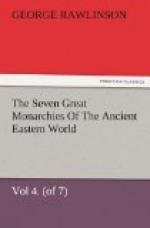[Illustration: PLATE XXV.]
The character of the remaining instruments is more doubtful. The sambuca seems to have been a large harp, which rested on the ground, like the harps of the Egyptians. The psaltery was also a stringed instrument, and, if its legitimate descendant is the modern santour, we may presume that it is represented in the hands of a Susianian musician on the monument which is our chief authority for the Oriental music of the period. The symphonia is thought by some to be the bagpipe, which is called sampogna by the modern Italians: by others it is regarded as a sort of organ.
The Babylonians used music, not merely in their private entertainments, but also in their religious ceremonies. Daniel’s account of their instruments occurs casually in his mention of Nebuchadnezzar’s dedication of a colossal idol of gold. The worshippers were to prostrate themselves before the idol as soon as they heard the music commence, and were probably to continue in the attitude of worship until the sound ceased.
The seclusion of women seems scarcely to have been practised in Babylonia with as much strictness as in most Oriental countries. The two peculiar customs on which Herodotus descants at length—the public auction of the marriageable virgins in all the towns of the empire, and the religious prostitution authorized in the worship of Beltis—were wholly incompatible with the restraints to which the sex has commonly submitted in the Eastern world. Much modesty can scarcely have belonged to those whose virgin charms were originally offered in the public market to the best bidder, and who were required by their religion, at least once in their lives, openly to submit to the embraces of a man other than their husband. It would certainly seem that the sex had in Babylonia a freedom—and not only a freedom, but also a consideration—unusual in the ancient world, and especially rare in Asia. The stories of Semiramis and Nitocris may have in them no great amount of truth; but they sufficiently indicate the belief of the Greeks as to the comparative publicity allowed to their women by the Babylonians.




